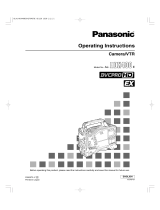E-12
ENGLISH
Scene File Operations
In the scene mode established upon completion of the scene data saving or loading operations,
the KNEE SLOPE, KNEE POINT, DETAIL, GAMMA and M.PED VR control operations differ
slightly from their regular operations.
Regular operations: The control positions are sent to the camera recorder as menu data
information.
Operations in scene mode: The data and control positions immediately after scene data saving
or loading serve as the reference for operation. In the case of the
control data, the changes from the data immediately after saving or
loading are sent to the camera recorder.
<Notes>
≥
Depending on the positions of the controls during saving and loading, the lower or upper limits of the
data variable ranges may be exceeded by the control variable ranges. In this case, when a particular
control is operated after saving or loading, its data will be changed as normal up to the lower or
upper limit, but the data will not change any further once the limit is exceeded. Furthermore, when a
particular control is stopped at the position where the lower or upper limit is exceeded, this stopped
position will serve as the position that indicates the lower or upper limit value.
≥ While the scene mode is established, the VTR operations can be performed by setting the
VTR/SCENE enable switch to REC ONLY or VTR ON just as with regular operations.
Operation mode established by scene file data <scene mode>
Releasing the scene mode
To release the scene mode, proceed as follows.
As soon as the regular operation mode has
been restored from the scene mode, the KNEE
POINT, KNEE SLOPE, DETAIL, GAMMA and
M.PED VR control item data changes to the
control position data which was established at
that point when the scene mode was released.
Furthermore, the data established during the
scene mode is used as is for all data with the
exception of the control data.
Example: Scene No.2 while the scene mode is
established
1 Press the LOAD button.
All the button LEDs now go off.
<Notes>
≥ The scene mode is automatically released
when the power of the camera recorder and
HEAD POWER switch on the base station are
turned off.
≥ The scene is also automatically released
when the saving operation has failed and
there is no data to be loaded.




















